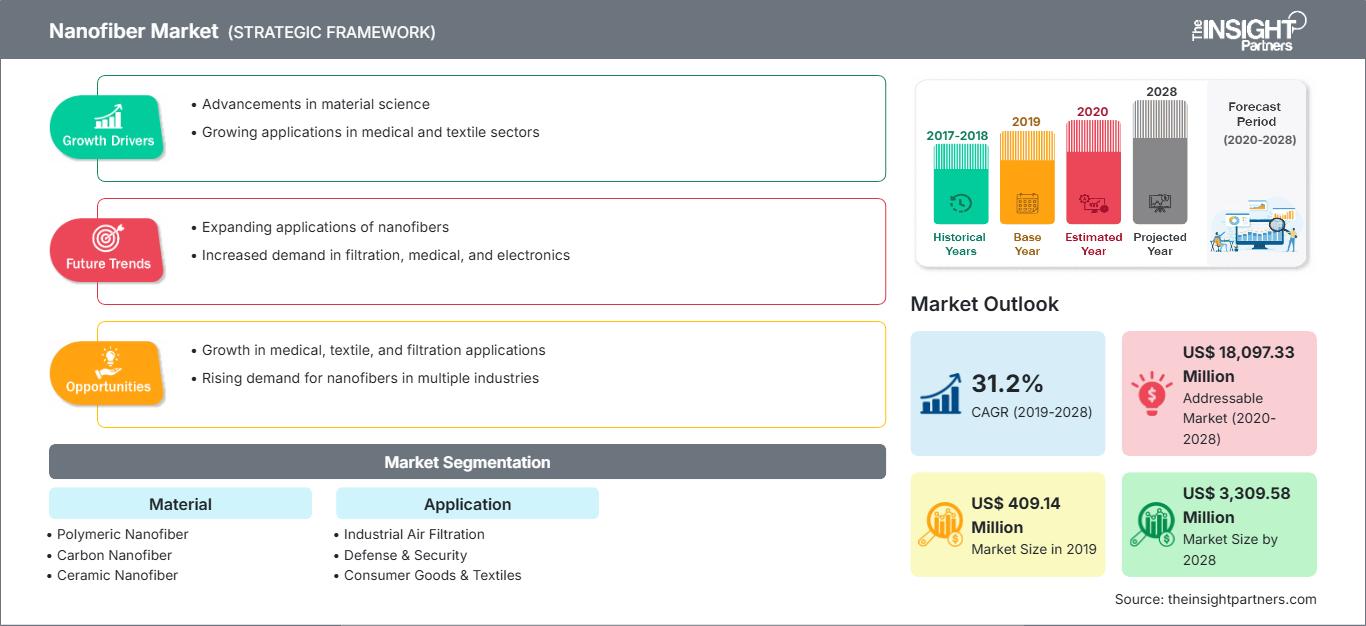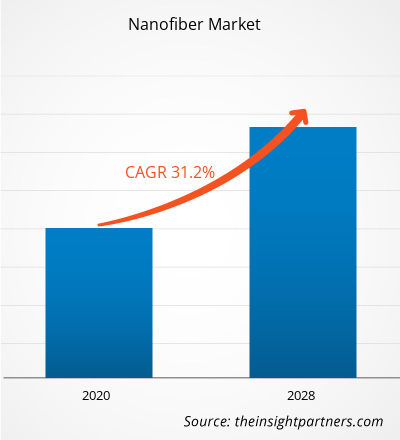나노섬유 시장은 2019년 4억 914만 달러 규모였으며, 2028년에는 33억 958만 달러에 이를 것으로 예상됩니다. 2020년부터 2028년까지 연평균 성장률(CAGR)은 31.2%에 달할 것으로 예상됩니다.
나노섬유는 직경이 1µm 미만인 섬유입니다. 이 섬유는 투과율을 비교적 약간 낮추면서 여과 효율을 높이는 데 도움이 됩니다. 빠른 산업화 속도, 산업 응용 분야 증가에 따른 나노섬유 제품의 상용화 확대, 기술 혁신에 대한 지속적인 노력, 그리고 R&D 투자 증가는 나노섬유 시장 성장에 기여하는 주요 요인입니다.
2019년 아시아 태평양 지역은 나노섬유의 최대 시장이었습니다. 아시아 태평양 지역은 제조업 분야에서 높은 성장을 보이는 많은 개발도상국이 자리 잡고 있으며, 세계적인 제조 허브로 자리매김했습니다. 중국이 고숙련 제조업 중심지로 발전하는 가운데, 인도, 한국, 대만, 베트남 등 다른 개발도상국들은 저숙련 및 중숙련 제조 시설을 인건비가 저렴한 인접 국가로 이전하려는 여러 기업들을 유치하고 있습니다. 이들 국가 정부 또한 투자 아이디어를 개선하거나 외국인 직접 투자(FDI)를 장려함으로써 이러한 기업들을 환영하고 있습니다.
코로나19는 정부의 봉쇄, 여행 금지, 사업 중단으로 인해 여러 국가의 경제와 산업에 악영향을 미치고 있습니다. 화학 및 소재 산업은 공급망 붕괴, 기술 행사 취소, 사무실 폐쇄 등 심각한 차질을 겪고 있는 주요 산업 중 하나입니다. 북미, 유럽, 아시아 태평양, 남미, 중동 및 아프리카 지역의 여러 공장들이 가동을 중단하면서 글로벌 공급망이 제한되고 제조 활동, 납품 일정 및 제품 판매에 차질이 발생했습니다. 더욱이, 여러 기업들은 이미 제품 납품 지연 및 향후 제품 판매 부진 가능성을 예측하고 있습니다. 유럽, 아시아, 북미 국가들의 여행 금지 조치는 기업 협력 및 파트너십 기회를 저해하고 있습니다. 이러한 제한 외에도, 사회적 거리두기 조치로 인한 노동 인력 부족과 생산 수준 저하가 화학 및 소재 산업과 관련 시장의 활동을 저해하는 요인입니다. 많은 국가들이 현재 정상화되고 있지만, 많은 국가들이 2차 확산을 경험하고 있습니다. 또한, 백신 접종 확대로 인해 향후 몇 달 안에 상황이 바뀔 가능성이 높습니다.
이 보고서의 일부, 국가 수준 분석, Excel 데이터 팩을 포함하여 모든 보고서에 대한 사용자 정의를 무료로 받을 수 있을 뿐만 아니라 스타트업 및 대학을 위한 훌륭한 제안 및 할인을 이용할 수 있습니다
나노섬유 시장: 전략적 통찰력

- 이 보고서의 주요 주요 시장 동향을 확인하세요.이 무료 샘플에는 시장 동향부터 추정 및 예측에 이르기까지 데이터 분석이 포함됩니다.
급속한 산업화 속도와 산업 공장의 유해 배출 감축 필요성
점점 더 많은 지역이 현지 제조 공장 도입에 투자함에 따라 세계 제조업 부문이 빠르게 확장되고 있습니다. 중국물류구매연합회(CFLP)에 따르면, 세계 제조업 부문의 구매관리자지수(PMI)는 2017년 10월 55.1이었고, 9월에는 55.9였습니다. 그러나 이 기간 동안 지수는 전반적으로 최고치를 기록했습니다. PMI 지수는 2017년 초 이후 약 53.5를 기록했는데, 이는 선진국 제조업 부문의 견조한 회복세, 신흥국의 산업 발전 가속화, 그리고 세계 시장의 원자재 가격 상승을 시사합니다. 급성장하는 제조업 부문은 공장 생산성 향상과 고객 선호도 변화에 대한 최신 정보를 지속적으로 제공함으로써 경쟁 우위를 확보하기 위해 기술 발전을 적극적으로 수용할 것으로 예상됩니다. 제조업은 현재 기술 르네상스의 한가운데에 있으며, 이는 현대 공장의 전망과 공정을 변화시키고 있습니다. 그러나 다양한 산업의 운영 확대는 특히 산업화가 심한 도시에서 환경적 위험에 기여하고 있습니다. 또한, 중공업화는 독성 배출을 통해 이러한 사업장 인근 주민의 건강에도 영향을 미치고 있습니다.
소재 분석
나노섬유 시장은 소재에 따라 고분자 나노섬유, 탄소 나노섬유, 세라믹 나노섬유, 유리 나노섬유 등으로 구분됩니다. 탄소 나노섬유 부문은 2020년 최대 점유율을 기록하며 나노섬유 시장을 선도했습니다. 탄소 나노섬유는 초고온에서 합성 고분자와 바이오 고분자에서 비탄소 원소를 제거하여 제조됩니다. 탄소 나노섬유 제조의 부유 촉매법에서는 분말 또는 지지체 형태의 다양한 금속을 촉매로 사용합니다. 포일, 거즈, 와이어 등은 나노섬유 생산에 사용되는 다른 촉매입니다. 탄소 나노섬유는 높은 불연속성과 상용성을 비롯한 여러 물리적 특성을 나타내며, 흑연성도 매우 높습니다. 우수한 기계적 특성과 높은 전기 및 열 전도성을 가지고 있습니다. 탄소 나노섬유의 응용 분야는 열가소성 플라스틱, 엘라스토머, 열경화성 수지, 세라믹, 엘라스토머, 금속 등입니다. 또한, 높은 인장 강도와 열 및 전기 전도성 덕분에 탄소 나노섬유는 정형외과, 치과, 조직 공학용 스캐폴드에도 널리 사용됩니다.
응용 분야 분석
응용 분야를 기준으로 나노섬유 시장은 산업용 공기 여과, 국방 및 보안, 소비재 및 섬유, 전자 부품, 전력 및 에너지, 의료 및 생명 과학, 화학 및 환경 등으로 세분화됩니다. 2020년에는 의료 및 생명 과학 분야가 가장 큰 점유율을 기록하며 시장을 선도했습니다. 나노섬유에 사용되는 생분해성 소재는 의료 및 헬스케어 산업에 가장 적합합니다. 또한, 첨가제를 통합함으로써 이러한 나노섬유의 다기능성을 확보할 수 있습니다. 구조와 크기를 제어할 수 있기 때문에 조직 공학에 사용될 수 있습니다. 생명 과학 및 제약 산업에서 나노섬유의 주요 응용 분야로는 약물 전달, 상처 치유, 조직 공학, 그리고 장벽 섬유 등이 있습니다. 나노섬유 시장의 주요 기업으로는 Ahlstrom-Munksjo, Asahi Kasei Corporation, Donaldson Company, Inc., DuPont, Nanofibers Solution LLC, Inc., Toray Industries, Inc., Espin Technologies, Elmarco SRO, Mempro Ltd., Revolution Fibers Ltd. 등이 있습니다. 시장의 주요 기업들은 인수합병, 제품 출시와 같은 전략에 집중하여 지역적 입지와 고객 기반을 확대하고 있습니다. 예를 들어, 2018년에 Donaldson은 운영자가 교체용 공기 필터를 더 쉽게 선택할 수 있도록 혁신적인 시스템을 도입하여 펄스 회복률과 수밀성을 정량화하기 위한 실험실 테스트를 개발했습니다.
보고서 스포트라이트
- 글로벌 나노섬유 시장의 진보적인 산업 동향은 플레이어가 효과적인 장기 전략을 개발하는 데 도움이 됩니다.
- 선진 및 개발도상 시장에서 운영되는 회사가 채택한 사업 성장 전략
- 2017년부터 2028년까지 글로벌 나노섬유 시장에 대한 정량적 분석
- 다양한 산업에서 나노섬유에 대한 수요 추정
- 시장 성장을 예측하기 위해 산업에서 운영하는 구매자와 공급업체의 효율성을 보여주는 PEST 분석
- 경쟁적인 시장 시나리오와 나노섬유 수요를 이해하기 위한 최근 개발
- 나노섬유 시장 성장을 주도하고 제한하는 요소와 결합된 시장 동향 및 전망
- 글로벌 나노섬유 시장 성장에 대한 상업적 관심을 뒷받침하는 계몽적인 전략은 의사결정 과정
- 다양한 시장 노드에서의 나노섬유 시장 규모
- 산업 역학과 함께 나노섬유 시장에 대한 자세한 개요 및 세분화
- 성장 기회가 유망한 다양한 지역의 나노섬유 시장 규모
나노섬유 시장 지역별 통찰력
The Insight Partners의 분석가들은 예측 기간 동안 나노섬유 시장에 영향을 미치는 지역별 동향과 요인들을 면밀히 분석했습니다. 이 섹션에서는 북미, 유럽, 아시아 태평양, 중동 및 아프리카, 그리고 중남미 지역의 나노섬유 시장 세분화 및 지역별 분포도 살펴봅니다.
나노섬유 시장 보고서 범위
| 보고서 속성 | 세부 |
|---|---|
| 시장 규모 2019 | US$ 409.14 Million |
| 시장규모별 2028 | US$ 3,309.58 Million |
| 글로벌 CAGR (2019 - 2028) | 31.2% |
| 이전 데이터 | 2017-2018 |
| 예측 기간 | 2020-2028 |
| 다루는 세그먼트 |
By 소재
|
| 포함된 지역 및 국가 | 북미
|
| 시장 선도 기업 및 주요 회사 프로필 |
|
나노섬유 시장 참여자 밀도: 비즈니스 역학에 미치는 영향 이해
나노섬유 시장은 소비자 선호도 변화, 기술 발전, 그리고 제품의 이점에 대한 인식 제고 등의 요인으로 인한 최종 사용자 수요 증가에 힘입어 빠르게 성장하고 있습니다. 수요가 증가함에 따라 기업들은 제품 라인업을 확장하고, 소비자 니즈를 충족하기 위한 혁신을 추진하며, 새로운 트렌드를 적극 활용하고 있으며, 이는 시장 성장을 더욱 가속화하고 있습니다.

- 을 얻으세요 나노섬유 시장 주요 주요 플레이어 개요
- 중합체 나노섬유
- 탄소 나노섬유
- 세라믹 나노섬유
- 유리 나노섬유
- 기타
나노섬유 시장 - 응용 분야별
- 산업용 공기 여과
- 소비재 및 섬유
- 전자 부품
- 국방 및 보안
- 전력 및 에너지
- 헬스케어 및 생명 과학
- 화학 및 환경
- 기타
회사 프로필
- Ahlstrom-Munksjo,
- Asahi Kasei Corporation
- Donaldson Company, Inc.
- DuPont
- Nanofibers Solution LLC, Inc.
- Toray Industries, Inc.
- Espin Technologie
- Elmarco SRO
- Mempro Ltd.
- Revolution Fibers Ltd.
- 과거 분석(2년), 기준 연도, CAGR을 포함한 예측(7년)
- PEST 및 SWOT 분석
- 시장 규모 가치/거래량 - 글로벌, 지역, 국가
- 산업 및 경쟁 환경
- Excel 데이터세트
최근 보고서
관련 보고서
사용 후기
구매 이유
- 정보에 기반한 의사 결정
- 시장 역학 이해
- 경쟁 분석
- 고객 인사이트
- 시장 예측
- 위험 완화
- 전략 기획
- 투자 타당성 분석
- 신흥 시장 파악
- 마케팅 전략 강화
- 운영 효율성 향상
- 규제 동향에 발맞춰 대응




















 무료 샘플 받기 - 나노섬유 시장
무료 샘플 받기 - 나노섬유 시장